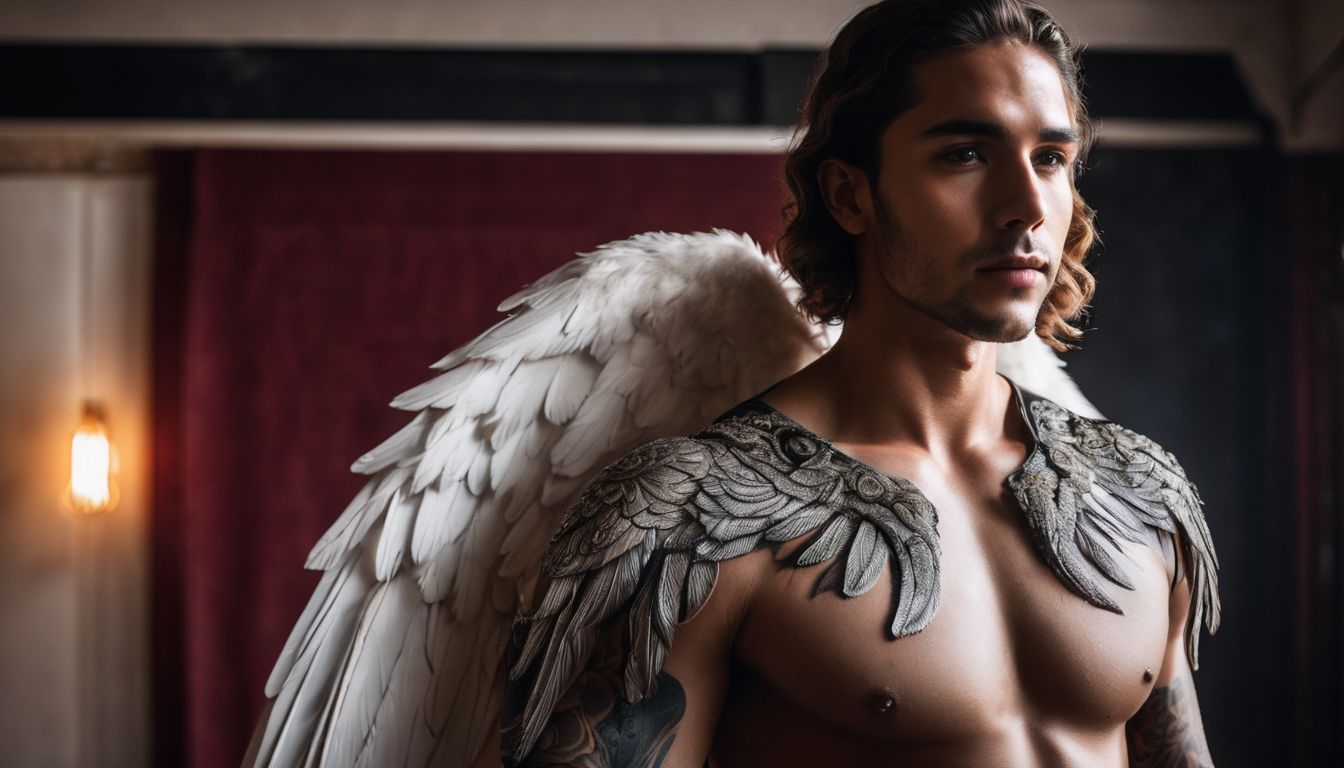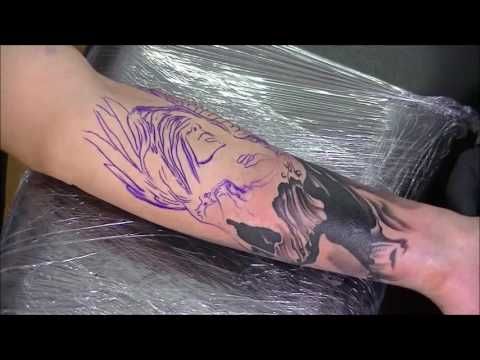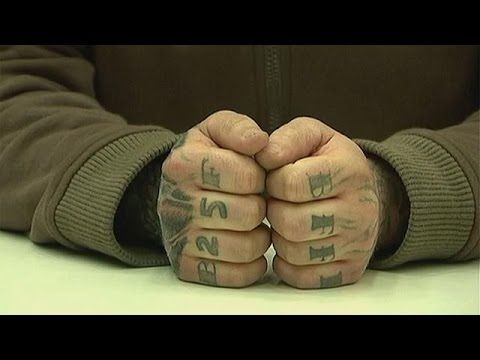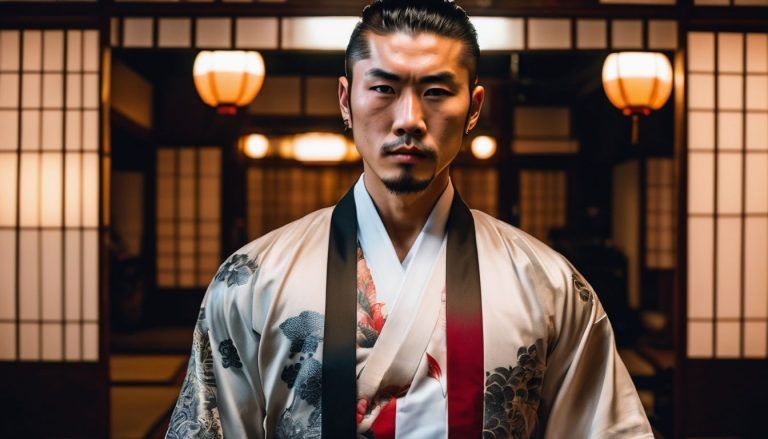Unveiling the Symbolism and Meaning Behind the Angel of Death Tattoo
Choosing the right tattoo can feel like a weighty decision, especially when it comes to designs steeped in symbolism. The Angel of Death tattoo captures attention with its potent representation of life’s finality and beyond.
This article sheds light on the complex meanings behind this iconic ink, guiding you through its historical significance and cultural impact. Dive into the mysteries of this profound emblem – keep reading to uncover what lies beneath its wings.
Key Takeaways
- The Angel of Death tattoo is rich in symbolism, representing mortality, fear, spiritual protection, and personal transformation.
- Common elements in this tattoo include broken wings for struggle or loss, scythes or swords for the inevitability of death, and clocks to symbolize life’s fleeting nature.
- Variations of the design can incorporate skulls to add darkness or religious symbols like crosses for faith; color choices like red may represent passion or rebirth.
- Apart from the Angel of Death theme, angel tattoos come in many forms such as guardian angels offering comfort and dark angels expressing inner conflicts or duality.
- Choosing an angel tattoo often reflects a person’s spirituality, beliefs about divine guidance and protection—or serves as tribute to loved ones.
Understanding the Symbolism and Meaning of Angel Tattoos
Angel tattoos represent ethereal beings who signify protection, guidance, but also reflect fear and mortality. They are a symbol of spirituality and divine intervention in various cultures and religions.
Representing ethereal beings
Angels in tattoos often capture the essence of celestial spirits. They bring to life mystical entities that are both awe-inspiring and comforting, embodying the idea of ethereal beings watching over humanity.
Artists create handdrawn designs that weave spirituality and artistry into a single form, conveying the notion of divine protection. Inked onto skin, these winged beings serve as perpetual reminders of something greater than ourselves existing in an otherworldly realm.
By choosing angelic figures for their tattoos, individuals connect with the spiritual symbolism associated with these heavenly creatures. They embrace beliefs about guardianship and hope or remember loved ones who have passed on.
The delicate features and flowing robes typical in depictions echo qualities often attributed to angels — purity, grace, and tranquility — transcending cultural and religious boundaries through their universal appeal.
Signifying protection and guidance
Symbolizing protection and guidance, the Angel of Death tattoo is deeply entrenched in spiritualism and divine symbolism. For those who wear this tattoo, it embodies a belief in ethereal beings watching over and guiding them through life’s trials.
The inked portrayal of the grim reaper signifies a powerful connection to higher powers, offering solace during times of struggle or uncertainty. This particular design resonates with many individuals who seek comfort in the idea of divine protection amidst life’s challenges.
Additionally, representing both fear and mortality, the Angel of Death tattoo remains a steadfast symbol for those navigating difficult personal journeys. Its depiction conveys an enduring belief that there is an unseen force providing guidance during times of sorrow or adversity.
Reflecting fear and mortality
The Angel of Death tattoo embodies a potent symbolism tied to fear and mortality. For many, the design serves as a reminder of life’s transient nature and the inevitability of death.
The tattoo often represents a deep-seated fear of mortality, reflecting an individual’s contemplation of their own existence in the face of inevitable passing. Furthermore, it signifies embracing this existential dread as part of life’s journey.
Tattered and broken wings in the Angel of Death tattoo can symbolize a struggle with faith or personal heartbreak, serving as visual reminders that even divine beings are not immune to suffering.
Popular Designs of Angel Tattoos
Angel tattoos come in various designs, including angel wings, archangels, and cherubim. Each design carries its own unique symbolism and meaning, making them popular choices for tattoo enthusiasts.
Angel wings
The symbolism behind angel wings in tattoos holds a deep significance, representing protection and the idea of an ethereal being watching over individuals. These designs often convey a sense of divine guidance and comfort during challenging times, serving as a reminder of spiritual support.
Additionally, broken or tattered angel wings in tattoos can symbolize personal struggles and heartbreak, reflecting the resilience to overcome hardships. Moreover, angel wing tattoos are popular for their depiction of grace and beauty, making them a meaningful choice for those seeking to express faith and hope through body art.
Moving forward to “Archangels”..
Archangels
Moving from the classic symbolism of angel wings, we delve into the powerful significance of archangels in tattoo designs. Archangels hold a special place in religious and spiritual folklore, representing divine messengers entrusted with protecting and guiding humanity.
These celestial beings are often depicted as warriors clad in armor, symbolizing strength and courage. The archangel Michael, for instance, embodies valor and righteousness, making him a popular choice for those seeking protection or guidance through difficult times.
Archangel tattoos can also signify a deep connection to faith and spirituality. Their presence on one’s skin serves as a constant reminder of divine support, offering solace during moments of uncertainty or fear.
Celtic angels
Transitioning from the powerful symbolism of archangels, Celtic angels carry a unique significance in tattoo art. These angels are often depicted with intricate knotwork and intertwining patterns, reflecting their connection to Celtic culture.
The designs typically incorporate elements such as crosses, animals, or nature-inspired imagery that hold deep symbolic meanings in Celtic tradition.
Traditionally associated with protection and guidance, Celtic angels symbolize strength and spirituality. Their presence is believed to bring harmony and balance into one’s life while providing a sense of divine support during challenging times.
Cupid
Cupid, an iconic figure in both mythology and tattoo art, symbolizes love and desire. Often depicted as a mischievous winged child with a bow and arrow, the Cupid tattoo represents romantic affection and has been popular for centuries.
The image of Cupid is often associated with Valentine’s Day but holds deeper significance beyond this holiday. It signifies not only romantic love but also the universal power of attraction, making it a versatile choice for those seeking to express feelings of passion or connection through body art.
The Cupid tattoo can be adapted in various ways to convey different meanings. Some may choose to include other symbols like hearts or flowers alongside Cupid to enhance the representation of love and sentimentality in their tattoos.
Fallen angels
The concept of fallen angels in tattoo art embodies a sense of rebellion and defiance. The design usually features angels with broken or tattered wings, symbolizing a fall from grace or a struggle against one’s fate.
This imagery often resonates with individuals who have experienced personal turmoil or internal conflict, conveying themes of resilience and overcoming adversity. The fallen angel tattoo can also serve as a powerful reminder that anyone can rise above their challenges and find redemption.
Those who choose to ink fallen angel tattoos may feel drawn to the deeper symbolism behind these designs, seeking to convey an emotional narrative through body art. This particular motif reflects the complexity of human experience, encapsulating both despair and hope within its wingspan.
Guardian angels
Guardian angels, a common theme in angel tattoos, symbolize protection and guidance. Many people believe that these celestial beings watch over them, providing comfort during difficult times.
The tattoo design often depicts an angel with outstretched wings, emanating a sense of safety and security. Individuals who choose this tattoo may seek reassurance or hope in their daily lives.
The concept of guardian angels is steeped in history and spirituality – serving as a powerful reminder of divine presence amidst life’s trials and tribulations. It is essential to understand the deep significance behind such tattoos before adorning one’s body with this timeless symbol.
Praying angels
Amid the various designs of angel tattoos, a prevalent choice is that of praying angels. These serene and meditative figures are often depicted with closed eyes, clasped hands, and folded wings, symbolizing hope, faith, and supplication.
Praying angels invoke a sense of calmness and spiritual connection for those seeking comfort or solace in challenging times.
The tattoo design captures the essence of divine intervention and conveys a solemn sense of prayerful devotion. The figure serves as a reminder of inner strength and belief in higher guidance during moments of uncertainty or distress.
Cherubim
Cherubim are a popular subject for angel tattoos, representing celestial beings with a close connection to God. Often depicted as plump, childlike figures with wings and rosy cheeks, cherubim symbolize innocence and divine love.
These angelic creatures convey a sense of purity, protection, and guidance in the tattoo world. The symbolism behind cherubim tattoos reflects an enduring belief in higher powers offering solace during challenging times.
Cherubim tattoos often feature these heavenly beings surrounded by symbols of love such as hearts or roses. The design exudes a sense of comfort and compassion while also serving as a reminder of the spiritual realm’s benevolent influence.
Warrior angels
The concept of warrior angels in tattoo art symbolizes strength, protection, and courage. These designs often depict angels wielding swords or engaged in battle, representing a sense of resilience against adversity.
Warrior angel tattoos are popular choices for those seeking symbols of empowerment and determination amidst life’s challenges.
These tattoos serve as a reminder that individuals have the inner strength to overcome obstacles and emerge victorious. The imagery can be deeply personal, reflecting the individual’s own battles and triumphs.
Embracing the spirit of warrior angels through body art empowers many to face their struggles with unwavering resolve.
Unveiling the Angel of Death Tattoo
This section will delve into the significance and symbolism behind the design of the Angel of Death tattoo, as well as the common elements featured in the tattoo and its variations.
If you’re intrigued by dark angel tattoos, this is a must-read!
Significance and symbolism behind the design
The Angel of Death tattoo design holds deep significance and symbolism, representing themes of fear, mortality, and personal transformation. Featuring tattered or broken wings, the tattoo signifies struggle with faith or heartbreak and can also symbolize rebirth and renewal.
It serves as a powerful reminder of suffering and sadness while embodying a sense of divine protection, offering comfort to those facing difficult times. The intricate symbolism within the Angel of Death tattoo captures varying personal beliefs and experiences.
Embodying a mystical beauty, the Angel of Death tattoo resonates deeply with individuals who have undergone disillusionment with their previous religious beliefs. Its significance in tattoo history highlights its role as an emblematic representation of profound human experiences and emotions.
Common elements featured in the tattoo
Embodied within the Angel of Death tattoo are common elements that hold significant symbolism and meaning for those who choose to ink this powerful design onto their skin:
- Tattered and broken wings are often incorporated into the tattoo, symbolizing a struggle with faith or personal heartbreak, reflecting the pain and suffering experienced in life.
- The use of a scythe or sword in the tattoo design represents mortality and the idea of death as an inevitable part of life, reminding individuals of the fleeting nature of existence.
- The portrayal of an angelic figure with a hooded cloak evokes an aura of mystery and darkness, adding depth to the symbolism by representing the enigmatic nature of death itself.
- Incorporating hourglasses or clocks within the tattoo signifies the passage of time and serves as a reminder to cherish each moment, emphasizing the ephemeral nature of life.
- The inclusion of roses or other flowers within the design symbolizes beauty blooming amidst hardship, reflecting hope, transformation, and new beginnings even in the face of death and sorrow.
- The depiction of angels weeping or mourning in the tattoo reflects themes of loss and grief while also conveying a sense of empathy and compassion towards others who may be struggling.
- Adding religious imagery such as crosses or religious symbols within the tattoo design can represent faith, spiritual guidance, and belief in divine protection during times of difficulty.
Variations of the tattoo
The Angel of Death tattoo comes in a variety of variations, each carrying its own distinct symbolism and meaning. Some common variations include:
- Tattered and broken wings symbolizing struggle with faith or personal heartbreak.
- Element of clock or hourglass representing the passage of time and mortality.
- Skulls or skeletal figures adding a dark and macabre element to the design.
- Incorporation of religious iconography such as crosses or rosary beads reflecting spiritual beliefs.
- Use of vibrant colors like red to symbolize strength, passion, or rebirth.
Other Meaningful Angel Tattoos
Explore other meaningful angel tattoos such as dark angels, winged crosses, and guardian angels with loved ones. These designs carry their own symbolism and significance for those who choose to ink them onto their skin.
Dark angels
Dark angels, as a tattoo design, represent a departure from the traditional concept of benevolent angelic beings. These tattoos often depict fallen or ominous angels with dark wings and somber expressions.
Dark angel tattoos capture the duality between good and evil, reflecting themes of inner turmoil and personal struggles. They symbolize an individual’s acknowledgment of their darker nature while also seeking redemption, making them a compelling choice for those who have overcome adversity or are navigating through challenging times.
The imagery in dark angel tattoos conveys a sense of mystery and introspection. The design frequently incorporates elements such as broken or tattered wings, veiled faces, or an overall melancholic aesthetic to illustrate the complex emotions associated with spiritual conflict.
Winged cross
Transitioning from the mystical symbolism of “Dark angels,” the inclusion of a winged cross in an angel tattoo design represents a blend of spiritual and celestial elements. The winged cross portrays an integration of mortality and divinity, symbolizing faith, protection, and guidance.
This meaningful tattoo signifies a harmonious connection between earthly existence and heavenly realms, reflecting a sense of transcendent spirituality.
The inclusion of a winged cross in an angel tattoo reflects the belief in divine intervention and ultimate salvation. It blends the traditional Christian symbol with ethereal imagery to convey profound spiritual significance.
Guardian angel with loved ones
The guardian angel with loved ones tattoo depicts a powerful message of protection and care for cherished individuals. This design often portrays an angel watching over children, family members, or friends.
Incorporating names or images of loved ones can personalize the tattoo, making it a meaningful tribute to those who hold a special place in one’s heart.
This tattoo serves as a constant reminder of the love and guidance received from these cherished individuals. It embodies feelings of warmth, comfort, and reassurance during challenging times.
Conclusion
Unveiling the Symbolism and Meaning Behind the Angel of Death Tattoo reveals a complex tapestry of emotions and beliefs. The tattoo is a potent symbol of defiance, struggle, and acceptance.
It signifies an individual’s journey through darkness towards enlightenment and inner peace. Ultimately, the Angel of Death tattoo serves as a powerful reminder of life’s fragility and the resilience that lies within each person.
FAQs
1. What does the Angel of Death tattoo symbolize?
The Angel of Death tattoo often symbolizes and reminds people of life’s fragility, the inevitability of death, and sometimes the idea of justice or vengeance.
2. Can I get an Angel of Death tattoo on my forearm?
Yes, you can get an Angel of Death tattoo on your forearm; it’s a popular spot for this meaningful design.
3. Is the Angel of Death tattoo only for certain people?
Nope! Anyone can choose to have an Angel of Death tattoo if they feel connected to its symbolic meanings related to life, death, or morality.
4. Will an Angel of Death tattoo look good in different sizes?
Absolutely! Whether big or small, an artist can design your Angel of Death Tattoo to suit any size that feels right for you.










